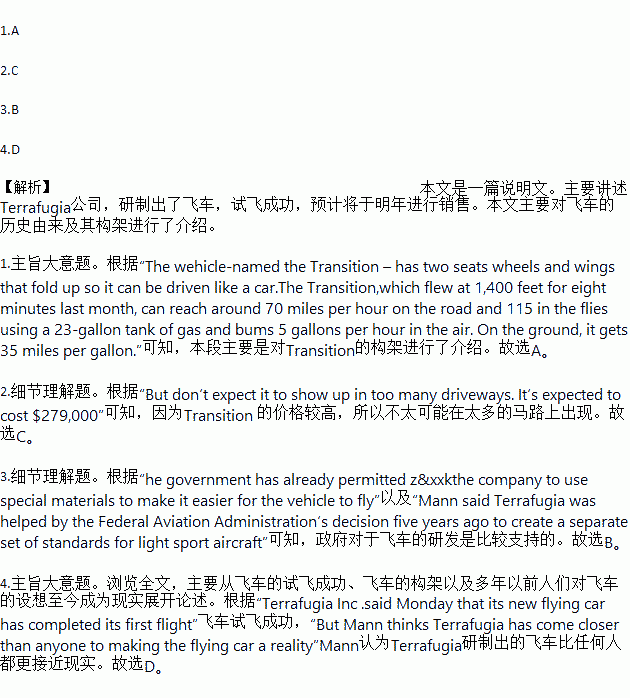题目内容
Terrafugia Inc. said Monday that its new flying car has completed its first flight, bringing the company closer to its goal of selling the flying car within the next year. The vehicle-named the Transition – has two seats, four wheels and wings that fold up so it can be driven like a car. The Transition, which flew at 1,400 feet for eight minutes last month, can reach around 70 miles per hour on the road and 115 in the air. It flies using a 23-gallon tank of gas and bums 5 gallons per hour in the air. On the ground, it gets 35 miles per gallon.
Around 100 people have already put down a $10,000 deposit to get a Transition when they go on sale, and those numbers will likely rise after Terrafugia introduces the Transition to the public later this week at the New York Auto Show. But don’t expect it to show up in too many driveways. It’s expected to cost $279,000.And it won’t help if you’re stuck in traffic. The car needs a runway.
Inventors have been trying to make flying cars since the 1930s, according to Robert Mann, an airline industry expert. But Mann thinks Terrafugia has come closer than anyone to making the flying car a reality. The govemment has already permitted the company to use special materials to make it easier for the vehicle to fly. The Transition is now going through crash tests to make sure it meets federal safety standards.
Mann said Terrafugia was helped by the Federal Aviation Administration’s decision five years ago to create a separate set of standards for light sport aircraft, which are lower than those pilots of larger planes Terrafugia says an owner would need to pass a test and complete 20 hours of flying time to be able to fly the Transition, a requirement pilots would find redatively easy to meet.
1.What is the first paragraph mainly about?
A. The basic data of the Transition. B. The advantages of flying cars.
C. The potential market for flying cars. C. The designers of the Transition.
2.Why is the Transition unlikely to show up in too many driveways?
A. It causes traffic jams. B. It is difficult to operate.
C. It is very expensive. D. It bums too much fuel.
3.What is the government’s attitude to the development of the flying car?
A. Cautious B. Favorable.
C. Ambiguous. D. Disapproving.
4.What is the best title for the text?
A. Flying Car at Auto Show B. The Transition’s Fist Flight
C. Pilots’Dream Coming True D. Flying Car Closer to Reality
 第1卷单元月考期中期末系列答案
第1卷单元月考期中期末系列答案

 them.”
them.”